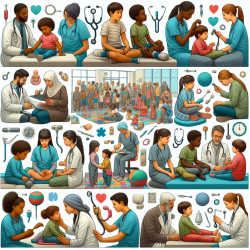Understanding the Link Between Child Marriage and Untreated Hypertension: What Practitioners Need to Know
As a Special Education Director, I often encounter various challenges that affect the well-being of students and their families. One of the more complex issues is understanding the long-term health implications of social practices such as child marriage. A recent study titled Child marriage and health disparities in adulthood: the differential risk of untreated hypertension among young adult women in India sheds light on this issue. This blog post will explore the study's findings and discuss how practitioners can use this information to improve their skills and encourage further research.
The Study's Key Findings
The research highlights a significant health disparity: young adult women in India who were married as children are at a greater risk of having untreated hypertension compared to their peers who married as adults. The study analyzed data from the National Family Health Survey (NFHS-4) and found that 72.6% of hypertensive women did not receive treatment, with child brides being 1.12 times more likely to have untreated hypertension.
Why This Matters
Hypertension is a leading risk factor for cardiovascular diseases, which are the primary cause of premature mortality worldwide. The lack of treatment for hypertension in child brides can exacerbate health issues, leading to severe long-term consequences. This underscores the importance of targeted health interventions and screenings for this vulnerable group.
Implications for Practitioners
As practitioners, understanding the social determinants of health is crucial for providing comprehensive care. Here are some actionable steps based on the study's findings:
- Regular Screening: Implement regular hypertension screenings for young women, especially those with a history of child marriage. Early detection can lead to timely intervention and treatment.
- Community Education: Educate communities about the health risks associated with child marriage and the importance of seeking medical care for hypertension.
- Policy Advocacy: Advocate for policies that support the health needs of women affected by child marriage, ensuring they have access to necessary healthcare services.
- Further Research: Encourage further research to explore the socio-biological mechanisms that contribute to untreated hypertension in this population.
Encouraging Further Research
The study opens the door for more in-depth research into the long-term health impacts of child marriage. Practitioners can play a pivotal role by participating in research initiatives, sharing data, and collaborating with academic institutions to deepen our understanding of these health disparities.
Conclusion
The link between child marriage and untreated hypertension is a critical public health issue that requires immediate attention. By integrating the study's findings into practice, practitioners can help mitigate the health risks faced by young women and contribute to broader efforts to eliminate child marriage.
To read the original research paper, please follow this link: Child marriage and health disparities in adulthood: the differential risk of untreated hypertension among young adult women in India.










